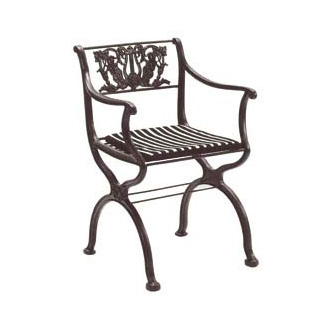This light low chair was designed in the fifties by Correa and Milá as an ironic tribute to the Barcelona chair by Mies van de Rohe. Though armless, it is surprisingly comfortable. Mies van de Rohe designed the Barcelona chair for the German Pavilion at the 1929 Universal Exposition and it was used as a «throne» for King Alfonso XIII during the opening ceremony.
The chair was first produced in the United States in 1948 and soon came to symbolize modernity and wealth. Correa and Milá's Barceloneta (named after one of Barcelona's working class neighbourhoods) is at once a tribute to van der Rohe's chair and a veiled criticism of its price. The Barceloneta chair was commissioned by architect José Antonio Coderch for several seafront flats he was building. In consonance with the aesthetic concerns of the day, Coderch strove to adapt the flats' furnishings to their setting.
The chair was designed for watching sailing boats on the water and for impromptu evenings overlooking the sea from a terrace or a sheltered porch. It is a chair for long summer nights, for whispering secrets and weaving dreams. Its unusually high sloping back cradles your head and invites you to relax. Its low, armless frame enables you to leave a book, a drink or a cigarette on the floor beside your chair and makes it easy to sit down or get up from your comfortable seat.
It is made from a beautifully crafted tongue-and-groove system which joins back leg, back and seat in a triangle. The chair is made of hard-wearing solid beech. The seat is kid leather. The back is made of tough white canvas. The back is easily removable and machine washable. Barceloneta calls forth the best of architecture, with its human scale and lucid simplicity. It is a chair that evokes memories and places. It is one of the best examples of Mediterranean rationalism.
Design:
Federico Correa
Alfonso Milá
Year:
1953
Manufacturer:
Santa & Cole
The chair was first produced in the United States in 1948 and soon came to symbolize modernity and wealth. Correa and Milá's Barceloneta (named after one of Barcelona's working class neighbourhoods) is at once a tribute to van der Rohe's chair and a veiled criticism of its price. The Barceloneta chair was commissioned by architect José Antonio Coderch for several seafront flats he was building. In consonance with the aesthetic concerns of the day, Coderch strove to adapt the flats' furnishings to their setting.
The chair was designed for watching sailing boats on the water and for impromptu evenings overlooking the sea from a terrace or a sheltered porch. It is a chair for long summer nights, for whispering secrets and weaving dreams. Its unusually high sloping back cradles your head and invites you to relax. Its low, armless frame enables you to leave a book, a drink or a cigarette on the floor beside your chair and makes it easy to sit down or get up from your comfortable seat.
It is made from a beautifully crafted tongue-and-groove system which joins back leg, back and seat in a triangle. The chair is made of hard-wearing solid beech. The seat is kid leather. The back is made of tough white canvas. The back is easily removable and machine washable. Barceloneta calls forth the best of architecture, with its human scale and lucid simplicity. It is a chair that evokes memories and places. It is one of the best examples of Mediterranean rationalism.
Design:
Federico Correa
Alfonso Milá
Year:
1953
Manufacturer:
Santa & Cole


























